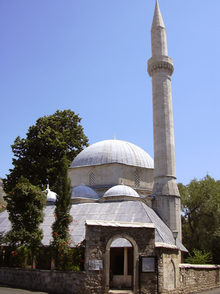Karađoz Bey Mosque
| Karagöz Bey Mosque | |
|---|---|
 Karađoz Bey Mosque | |
| Religion | |
| Affiliation | Sunni Islam |
| Location | |
| Location | Mostar, Bosnia and Herzegovina |
| Architecture | |
| Architect(s) | Mimar Sinan |
| Type | Mosque |
| Style | Ottoman architecture |
| Completed | 1557 |
| Specifications | |
| Length | 13 metres (43 ft) |
| Width | 13 metres (43 ft) |
| Dome(s) | 1 |
| Dome height (outer) | 16.49 metres (54.1 ft) |
| Dome height (inner) | 15.89 metres (52.1 ft) |
| Dome dia. (outer) | 10.72 metres (35.2 ft) |
| Minaret(s) | 1 |
| Minaret height | 34.50 metres (113.2 ft)[1] |
| Materials | stone |
Karagöz Bey Mosque (Bosnian: Karađoz-begova džamija, Turkish: Karagöz Mehmed Bey Camii) is a 16th-century Ottoman mosque in the city of Mostar, Bosnia and Herzegovina.
With its big dome and high minaret it is the largest in the region.
History
The Karađoz Bey Mosque mosque was built on the foundations of the Catholic church of Saint Stephen the Protomartyr.[2]
An Arabic foundation inscription on the mosque records that it was commissioned by Mehmed Beg b. Abu al-Saʿadat’ who was a brother of a vizier in the year AH 965 (1557-58). Some scholars have claimed that the vizier was the grand vizier Rüstem Pasha, but Rüstem Pasha is recorded as having only a single brother, Sinan Pasha.[3]
The mosque may have been designed by the imperial architect Mimar Sinan. It is in the form of a domed cube fronted by a double portico. The three domes of the inner portico are supported by four marble columns. The outer portico has a shed roof resting on small octagonal pillars. The large 10.65 metres (34.9 ft) dome of the mosque sits on an octagonal fenestrated drum which is supported by eight-pointed arches.[3]
The mosque was severely damaged during World War II, and faced near destruction during the Bosnian War in the early 1990s. However, Karađoz Mosque, like the rest of Mostar, underwent extensive repairs between 2002 and 2004. The mosque was completely renovated and reopened to the public in July 2004.
Notes
- ^ "Karađoz-begova džamija, graditeljska cjelina" [Karagöz Bey Mosque, architectural complex] (in Bosnian). Commission for the Preservation of National Monuments of Bosnia and Herzegovina. 4 May 2004. Archived from the original on 1 February 2014. Retrieved 19 January 2014.
- ^ Marić 2006, p. 247.
- ^ a b Necipoğlu 2005, p. 441.
References
Booksa
- Necipoğlu, Gülru (2005). The Age of Sinan: Architectural Culture in the Ottoman Empire. London: Reaktion Books. ISBN 978-1-86189-253-9.
{{cite book}}: Invalid|ref=harv(help)
Journals
- Marić, Ante (2006). "Biskupska kuća u Vukodolu" [The episcopal residence in Vukodol]. Hum (in Croatian) (1): 245–249.
43°20′28″N 17°48′50″E / 43.34111°N 17.81389°E
- Mosques in Bosnia and Herzegovina
- Mosques converted from churches in the Ottoman Empire
- Church buildings converted to a different denomination
- Attacks on religious buildings and structures during the Bosnian War
- Ottoman mosques in Bosnia and Herzegovina
- Mimar Sinan buildings
- 16th-century mosques
- National Monuments of Bosnia and Herzegovina
- Buildings and structures in Mostar
- Medieval Bosnia and Herzegovina architecture
- Bosnia and Herzegovina building and structure stubs
- European mosque stubs


